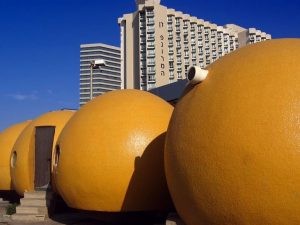A barge carrying 500 tons of phosphate capsized in Upper Egypt last week after a run-in with a bridge foundation. According to Egyptian newspaper Al-Ahram, the ship flipped after colliding with the Dandara Bridge in Qena, about 40 miles north of Luxor, dumping 1 million pounds of phosphate into the Nile River. Egypt’s Minister of Irrigation (MOI) Hossam Moghazi declared a state of extreme emergency as a precautionary measure. So what exactly are we looking at here?
“Phosphate is not soluble in water so there is little risk of poisoning the drinking water, though the ministry has notified Qena’s potable water station to take necessary precautions,” ministry official Khalled Wassef told Ahram Online. He affirmed that the Nile’s water remains fit for human use and that water samples extracted from the river at the site of the collision show “normal quality” levels.
Nevertheless, according to a statement released by the Egyptian cabinet, the Environment Ministry has set up an operations center to coordinate between the different state agencies and to support ongoing investigations. The MOI and army are overseeing dredgers tasked with removing the material from the riverbed. The looming question is what type of phosphate was this?
Phosphates are natural salt derivatives of the element phosphorus, negatively charged ions that link with positively charged ions such as sodium, potassium, ammonium, lead, and barium, each greatly changing how phosphate behaves. The fact that the MOI called this phosphate salt ‘insoluble’ suggests that the chemical makeup of the spill is known to authorities, however, without divulging the nature of the shipment, it is impossible for the public to gauge spill toxicity.
Phosphates occur in small amounts in all aquatic environments, critical to support the growth and metabolism of plants and animals. However, in excess amounts, they can cause runaway bacterial growth and trigger ecologically harmful algae blooms that heavily impact the health of the water and its inhabitants. If the phosphate salt involved in this accident is insoluble, and considering the constant flow of the Nile, the environmental implications could be negligible, but details have yet to be reported.
Some phosphates (aluminum phosphate as example) would present human health risks such as skin irritation and – if ingested – abdominal pain, nausea, and diarrhea. Others (such as highly toxic lead phosphate) would leach into the water at a low concentration, but stay present for a long time if the spill is not quickly cleaned up. Without having more specific information about the nature of the material, it is impossible to foretell health risks. Egypt is heavily dependent on the Nile River for its water supply, pulling 55 billion cubic meters from it annually, yet urgency to frame the seriousness of the spill and mitigate the effects seems absent. Some observers suggest to avoid using water from the spill area as much as possible until results of the environmental results are released, not so simple in water-starved Egypt.
Phosphate comprises one of the most important functional segments of the food chain. It enhances food characteristics in cereal and cheese, ice cream and puddings. It’s an element in chicken production and in both canned and fresh vegetables too. They also have many non-food benefits. Phosphates appear in agricultural fertilizer, detergent, toothpaste, soft drinks, flame retardants and water softeners.
Centuries ago, we culled our phosphorus from animal bones and urine. Today, its sourced from mined phosphate rock. Phosphates are essential to human, animal and plant life (phosphorus-containing compounds are vital to photosynthesis). They have critical functions in key biochemical processes such as metabolism.
Learn more about phosphorous and phosphates (and the disastrous impacts of Big Food on both) in this story from the Green Prophet archives, link here.





If this is mined phosphate, it is in the calcium bound state ( Ca3(PO4)2 ), with some of the magnesium form. Both are nearly insoluble. It will leach very slowly into the water. It should be possible to recover the phosphate by dredging.
Thanks for the comment – we’ll follow local news for updates, and aim to report back with specific findings if and when they are released.